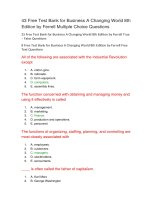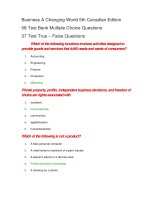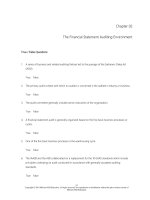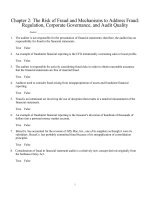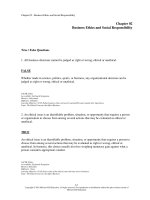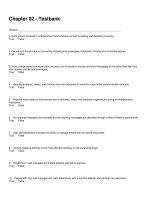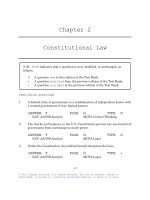Business a changing world 9th edition ferrell test bank
Bạn đang xem bản rút gọn của tài liệu. Xem và tải ngay bản đầy đủ của tài liệu tại đây (426.8 KB, 89 trang )
Chapter 02
Business Ethics and Social Responsibility
True / False Questions
1.
Business ethics refers to principles and standards that determine acceptable conduct in business
organizations.
True
2.
Ethics and social responsibility mean the same thing.
True
3.
False
Nearly all business decisions may be judged as right or wrong, ethical or unethical.
True
4.
False
False
The most basic ethical concerns have been formalized through laws and regulations that
encourage conformity to society's values and norms.
True
5.
False
All a business has to do to maintain ethical conduct is to follow the law.
True
False
2-1
© 2014 by McGraw-Hill Education. This is proprietary material solely for authorized instructor use. Not authorized for sale or distribution
in any manner. This document may not be copied, scanned, duplicated, forwarded, distributed, or posted on a website, in whole or part.
6.
Only corporations have to worry about ethics scandals and social responsibility issues.
True
False
Multiple Choice Questions
7.
The principles and standards that determine acceptable conduct in business are referred to as
A. norms.
B. strategies.
C. ethics.
D. laws.
E. rules.
8.
Social ______ relates to a business's impact on society.
A. responsibility
B. strategy
C. ethics
D. law
E. rule
2-2
© 2014 by McGraw-Hill Education. This is proprietary material solely for authorized instructor use. Not authorized for sale or distribution
in any manner. This document may not be copied, scanned, duplicated, forwarded, distributed, or posted on a website, in whole or part.
9.
The ______ Act criminalized securities fraud and toughened penalties for corporate fraud.
A. Dodd-Frank
B. Federal Trade Commission
C. Foreign Corrupt Practices
D. Sarbanes-Oxley
E. Sherman Antitrust
10. What is considered ethical may differ depending on the ___ in which a business operates.
A. city
B. culture
C. trade bloc
D. hemisphere
E. industry
11. Which of the following statements about business ethics is false?
A. It concerns the impact of a business's activities on society.
B. It refers to principles and standards that define acceptable behavior in business organizations.
C. It relates to an individual's values and moral standards and the resulting business decisions he
or she makes.
D. What is ethical is determined by the public, government regulators, interest groups,
competitors, and each individual's personal moral values.
E. Studying it can help you recognize ethical issues and understand how others make unethical
decisions.
2-3
© 2014 by McGraw-Hill Education. This is proprietary material solely for authorized instructor use. Not authorized for sale or distribution
in any manner. This document may not be copied, scanned, duplicated, forwarded, distributed, or posted on a website, in whole or part.
12. Studying business ethics will not necessarily
A. help you recognize ethical issues.
B. help you understand the importance of ethical decisions.
C. inform you about the impact of the work group on ethical decisions.
D. describe the ethical decision-making process.
E. tell you what you ought to do.
13. One of the most difficult things for a business to restore after an ethics scandal is
A. regulations.
B. jobs.
C. trust.
D. profits.
E. morale.
14. The Sarbanes-Oxley Act was passed to
A. punish those who committed accounting fraud in the late 1990s.
B. improve corporate profits.
C. help laid-off employees get their jobs back.
D. help investors recoup their losses.
E. help restore confidence in Corporate America.
2-4
© 2014 by McGraw-Hill Education. This is proprietary material solely for authorized instructor use. Not authorized for sale or distribution
in any manner. This document may not be copied, scanned, duplicated, forwarded, distributed, or posted on a website, in whole or part.
15. Which of the following have not been cited in your text as incidents of unethical business activity
recently?
A. Unfair competitive practices in the computer industry
B. Deceptive advertising of food and diet products
C. Accounting fraud
D. Stealing via the Internet
E. Corporate charitable giving
16. Which of the following statements is false?
A. Ethical issues are limited to for-profit organizations.
B. Business ethics goes beyond legal issues.
C. Ethical conduct builds trust among individuals and in business relationships.
D. Ethical conflicts may evolve into legal disputes.
E. Regardless of what an individual feels about a particular action, if society judges it to be
unethical, that judgment affects the organization's ability to achieve its objectives.
Essay Questions
2-5
© 2014 by McGraw-Hill Education. This is proprietary material solely for authorized instructor use. Not authorized for sale or distribution
in any manner. This document may not be copied, scanned, duplicated, forwarded, distributed, or posted on a website, in whole or part.
17. What is business ethics?
18. Choose an issue that has been prominently featured in the news and discuss the ethical
implications of this issue. Make sure to define any key terms that you use in your response.
True / False Questions
19. An ethical issue is an identifiable problem, situation, or opportunity that requires a person or
organization to choose from among several actions that may be evaluated as ethical or unethical.
True
False
2-6
© 2014 by McGraw-Hill Education. This is proprietary material solely for authorized instructor use. Not authorized for sale or distribution
in any manner. This document may not be copied, scanned, duplicated, forwarded, distributed, or posted on a website, in whole or part.
20. The best way to judge the ethics of a decision is to look at it from a manager's or employee's point
of view.
True
False
21. Theft of time is the leading area of misconduct observed in the workplace.
True
False
22. Conflicts of interest are payments, gifts, or special favors intended to influence the outcome of a
decision.
True
False
23. Ethics is related to the culture in which a business operates.
True
False
24. Workplace bullying is an increasing problem.
True
False
25. It is almost always easy to recognize specific ethical issues.
True
False
Multiple Choice Questions
2-7
© 2014 by McGraw-Hill Education. This is proprietary material solely for authorized instructor use. Not authorized for sale or distribution
in any manner. This document may not be copied, scanned, duplicated, forwarded, distributed, or posted on a website, in whole or part.
26. If a manager chooses to act so that she benefits financially or otherwise at the expense of her firm,
then she
A. is bullying.
B. is engaging in bribery.
C. has a conflict of interest.
D. is cheating.
E. has broken the law.
27. Managers use the ______ of their position to influence employees' decisions and actions.
A. authority
B. standards
C. scope
D. responsibility
E. acceptance
28. ____ involves taking someone else's work and presenting it as your own.
A. Conflict of interest
B. Bullying
C. Manipulation
D. Bribery
E. Plagiarism
2-8
© 2014 by McGraw-Hill Education. This is proprietary material solely for authorized instructor use. Not authorized for sale or distribution
in any manner. This document may not be copied, scanned, duplicated, forwarded, distributed, or posted on a website, in whole or part.
29. That businesspeople are expected not to harm customers, clients, and competitors knowingly
through deception, misrepresentation, coercion, or discrimination is part of
A. fairness and honesty.
B. communications.
C. conflict of interest.
D. business relationships.
E. consumerism.
30. If Sony was investigated for allegedly raising prices of its PlayStation excessively during the
Christmas buying season and thereby manipulating the supply of games available at that time, this
would be an ethical issue concerned primarily with
A. conflict of interest.
B. communications.
C. fairness and honesty.
D. cost control.
E. game rules.
31. Making claims about dietary supplements or the health benefits of certain unproven ingredients is
an issue related to
A. conflict of interest.
B. communications.
C. product design.
D. business relationships.
E. financing.
2-9
© 2014 by McGraw-Hill Education. This is proprietary material solely for authorized instructor use. Not authorized for sale or distribution
in any manner. This document may not be copied, scanned, duplicated, forwarded, distributed, or posted on a website, in whole or part.
32. The warning on cigarette packages about the health implications of smoking is an example of
which of the following ethical issues?
A. Conflict of interest
B. Fairness and honesty
C. Communications
D. Relationships within a business
E. Environmental issues
33. The following behavior is an example of ethical consideration within business relationships:
A. keeping company secrets.
B. communicating with customers.
C. whistleblowing.
D. obeying environmental laws.
E. donating to local charities.
34. If a manager pressures a subordinate to engage in activities that he or she may otherwise view as
unethical, such as engaging in accounting fraud or stealing a competitor's secrets, there exists an
ethical issue related to
A. plagiarism.
B. business relationships.
C. communications.
D. fairness and honesty.
E. conflicts of interest.
2-10
© 2014 by McGraw-Hill Education. This is proprietary material solely for authorized instructor use. Not authorized for sale or distribution
in any manner. This document may not be copied, scanned, duplicated, forwarded, distributed, or posted on a website, in whole or part.
35. If an employee learned of a significant cost-saving idea from a coworker and then informed
management of the idea without revealing its true source, then the employee would be involved
in
A. keeping a secret.
B. career advancement.
C. plagiarism.
D. bullying.
E. bribery.
Essay Questions
36. What are some of the general ethical issues in business?
2-11
© 2014 by McGraw-Hill Education. This is proprietary material solely for authorized instructor use. Not authorized for sale or distribution
in any manner. This document may not be copied, scanned, duplicated, forwarded, distributed, or posted on a website, in whole or part.
37. How do you recognize an ethical issue in business?
True / False Questions
38. Establishing and enforcing ethical standards and policies within business can help reduce unethical
behavior by prescribing which activities are acceptable and which are not and by removing the
opportunity to act unethically.
True
False
39. Without a code of ethics or formal policy on ethics, employees are likely to base their decisions on
how their peers and superiors behave.
True
False
40. Codes of ethics foster ethical behavior because they expand the opportunity to behave
unethically.
True
False
2-12
© 2014 by McGraw-Hill Education. This is proprietary material solely for authorized instructor use. Not authorized for sale or distribution
in any manner. This document may not be copied, scanned, duplicated, forwarded, distributed, or posted on a website, in whole or part.
41. Ethical decisions in an organization are influenced by three key factors.
True
False
42. Codes of ethics are formalized rules and standards that describe what the company expects of its
employees.
True
False
Multiple Choice Questions
43. Many employees utilize different _____ at work than they do at home.
A. ethical standards
B. codes of ethics
C. conflicts of interest
D. communication skills
E. body language
44. A large number of ____ cases result in retaliation against the employee, even though the
government has tried to take steps to protect workers and to encourage reporting of misconduct.
A. executive
B. white collar crime
C. whistleblower
D. petty theft
E. federal
2-13
© 2014 by McGraw-Hill Education. This is proprietary material solely for authorized instructor use. Not authorized for sale or distribution
in any manner. This document may not be copied, scanned, duplicated, forwarded, distributed, or posted on a website, in whole or part.
45. A set of formalized rules and standards that describe what a company expects of its employees is
called a(n)
A. code of ethics.
B. opportunity.
C. moral philosophy.
D. guideline.
E. law.
46. ____ is the act of an employee exposing an employer's wrongdoing to outsiders.
A. Fraud
B. Whistleblowing
C. Plagiarism
D. Bullying
E. A criminal lawsuit
47. Codes of ethics foster ethical behavior by
A. expanding the opportunity to behave unethically by providing rewards for following the rules.
B. limiting the opportunity to behave unethically by providing punishments for violations of the
rules and standards.
C. limiting the opportunity to behave unethically by providing rewards for violations of the rules
and standards.
D. expanding the opportunity to behave ethically by providing punishments for following the rules.
E. encouraging employees to bend the rules.
2-14
© 2014 by McGraw-Hill Education. This is proprietary material solely for authorized instructor use. Not authorized for sale or distribution
in any manner. This document may not be copied, scanned, duplicated, forwarded, distributed, or posted on a website, in whole or part.
48. Unethical behavior in business can be reduced if management does all of the following except
A. establishes clear policies on unethical behavior.
B. limits opportunities for unethical behavior.
C. establishes formal rules and procedures.
D. punishes unethical behavior firmly.
E. depends totally on employees' personal ethics.
49. According to the text, ethical decisions in an organization are influenced by (1) individual moral
standards, (2) the influence of managers and co-workers, and (3)
A. religious values.
B. informal ethical policies or rules.
C. opportunity to engage in misconduct.
D. family influence.
E. the founder's values.
50. Which of the following should help reduce the incidence of unethical behavior in an organization?
A. Understanding that individual moral standards, the influence of managers and coworkers, and
opportunity influence ethical behavior
B. Maximizing ethical conflict in work groups
C. Expanding opportunity by providing punishments for violations of the rules
D. Overlooking violations of codes of ethics
E. Retaliating against whistleblowers
2-15
© 2014 by McGraw-Hill Education. This is proprietary material solely for authorized instructor use. Not authorized for sale or distribution
in any manner. This document may not be copied, scanned, duplicated, forwarded, distributed, or posted on a website, in whole or part.
51. A code of ethics represents ____________ rules and standards of what a company expects of its
employees.
A. team
B. unceremonious
C. authority
D. formalized
E. situational
Essay Questions
52. How can an organization improve ethical behavior?
2-16
© 2014 by McGraw-Hill Education. This is proprietary material solely for authorized instructor use. Not authorized for sale or distribution
in any manner. This document may not be copied, scanned, duplicated, forwarded, distributed, or posted on a website, in whole or part.
53. Why is it increasingly common for organizations to have a code of ethics and compliance
programs?
True / False Questions
54. There are four dimensions of social responsibility: economic, legal, ethical, and voluntary.
True
False
55. The concept of social responsibility is universally accepted.
True
False
56. One of the dimensions of social responsibility is philosophical.
True
False
57. Increasingly, companies are introducing eco-friendly and socially responsible products to satisfy
consumer demand and improve their images.
True
False
2-17
© 2014 by McGraw-Hill Education. This is proprietary material solely for authorized instructor use. Not authorized for sale or distribution
in any manner. This document may not be copied, scanned, duplicated, forwarded, distributed, or posted on a website, in whole or part.
58. Corporate citizenship is the extent to which businesses meet the legal, ethical, economic, and
voluntary responsibilities placed on them by their owners.
True
False
59. Voluntary responsibilities are optional activities that promote human welfare or goodwill.
True
False
Multiple Choice Questions
60. __________________ is the extent to which businesses meet the legal, ethical, economic and voluntary
responsibilities placed on them by their stakeholders.
A. A code of conduct
B. A code of ethics
C. Fairness
D. Corporate citizenship
E. Whistleblowing
61. Obeying the law is a business's __________.
A. right
B. choice
C. economic responsibility
D. legal responsibility
E. ethical responsibility
2-18
© 2014 by McGraw-Hill Education. This is proprietary material solely for authorized instructor use. Not authorized for sale or distribution
in any manner. This document may not be copied, scanned, duplicated, forwarded, distributed, or posted on a website, in whole or part.
62. Avoiding misconduct and doing what is right, just, and fair relates to a business's
A. economic responsibility.
B. corporate citizenship.
C. legal responsibility.
D. ethical responsibility.
E. government responsibility.
63. Which is not a dimension of social responsibility?
A. Legal
B. Philosophic
C. Economic
D. Voluntary
E. Ethical
64. Being profitable relates to which social responsibility dimension?
A. Economic
B. Voluntary
C. Ethical
D. Legal
E. Corporate citizenship
2-19
© 2014 by McGraw-Hill Education. This is proprietary material solely for authorized instructor use. Not authorized for sale or distribution
in any manner. This document may not be copied, scanned, duplicated, forwarded, distributed, or posted on a website, in whole or part.
65. Which of the following is not one of the dimensions of social responsibility?
A. Voluntary
B. Economic
C. Legal
D. Ethical
E. Citizenship
66. Philanthropic contributions made by a business to a charitable organization represent which
dimension of social responsibility?
A. Corporate citizenship
B. Economic
C. Legal
D. Ethical
E. Voluntary
67. Studies have found a direct link between social responsibility and _________ in business.
A. profitability
B. ethics
C. declining stock prices
D. happiness of stakeholders
E. global warming
Essay Questions
2-20
© 2014 by McGraw-Hill Education. This is proprietary material solely for authorized instructor use. Not authorized for sale or distribution
in any manner. This document may not be copied, scanned, duplicated, forwarded, distributed, or posted on a website, in whole or part.
68. What are the four dimensions of social responsibility?
69. Discuss what companies have done to address environmental concerns and to become more
sustainable.
True / False Questions
70. Without employees, a business cannot carry out its goals.
True
False
2-21
© 2014 by McGraw-Hill Education. This is proprietary material solely for authorized instructor use. Not authorized for sale or distribution
in any manner. This document may not be copied, scanned, duplicated, forwarded, distributed, or posted on a website, in whole or part.
71. Recycling is a business response to employee issues.
True
False
72. The right to safety requires that businesses provide a safe place for consumers to shop.
True
False
73. A major social responsibility for business is providing equal opportunities for all employees.
True
False
74. Sustainability involves conducting activities so as to provide for the long-term well-being of the
natural environment, including all biological entities.
True
False
75. Managers consider social responsibility on an annual basis.
True
False
Multiple Choice Questions
2-22
© 2014 by McGraw-Hill Education. This is proprietary material solely for authorized instructor use. Not authorized for sale or distribution
in any manner. This document may not be copied, scanned, duplicated, forwarded, distributed, or posted on a website, in whole or part.
76. _____ is the activities that individuals, groups, and organizations undertake to protect their rights as
consumers.
A. Consumerism
B. Civil rights
C. Protectionism
D. Conspicuous consumption
E. Shopping
77. John F. Kennedy's consumer bill of rights outlined four rights: the right to be informed, the right to
choose, the right to be heard, and the right to
A. regulations.
B. service.
C. easy credit.
D. shop wherever you want.
E. safety.
78. Consumers vote against firms they view as socially irresponsible by not
A. boycotting the company's products.
B. expressing dissatisfaction by protesting.
C. writing their representatives in Congress.
D. buying the company's products.
E. filing complaints with the company.
2-23
© 2014 by McGraw-Hill Education. This is proprietary material solely for authorized instructor use. Not authorized for sale or distribution
in any manner. This document may not be copied, scanned, duplicated, forwarded, distributed, or posted on a website, in whole or part.
79. Water and soil pollution from oil and gas drilling is primarily what type of concern?
A. Consumer relations
B. Environmental issues
C. Community relations
D. Employee relations
E. Relations with stockholders
80. Which of the following is not an area of environmental concern in society today?
A. Animal rights
B. Land pollution
C. Waste disposal
D. The hard-core unemployed
E. Business practices that harm endangered wildlife
81. Laws regarding safety in the workplace are enforced by the _______.
A. Federal Trade Commission
B. Occupational Safety and Health Administration
C. Environmental Protection Agency
D. consumer bill of rights
E. codes of ethics
2-24
© 2014 by McGraw-Hill Education. This is proprietary material solely for authorized instructor use. Not authorized for sale or distribution
in any manner. This document may not be copied, scanned, duplicated, forwarded, distributed, or posted on a website, in whole or part.
82. One role of the FTC's Bureau of Consumer Protection is to protect consumers from ___________.
A. ethics
B. fraud
C. laws
D. power
E. unity of command
83. The most common way that businesses exercise community responsibility is through.
A. codes of ethics.
B. environmental reports.
C. obeying the law.
D. recycling.
E. contributions to charitable organizations.
84. The fact that environmental responsibility requires trade-offs means that it
A. should not be done.
B. is impossible.
C. generates profits.
D. imposes costs on both business and the public.
E. is not a good idea.
2-25
© 2014 by McGraw-Hill Education. This is proprietary material solely for authorized instructor use. Not authorized for sale or distribution
in any manner. This document may not be copied, scanned, duplicated, forwarded, distributed, or posted on a website, in whole or part.
